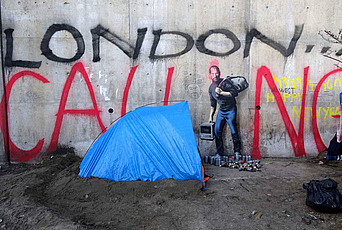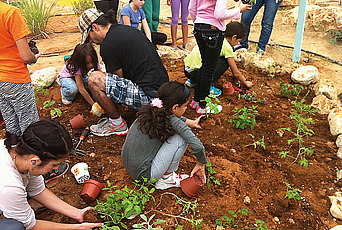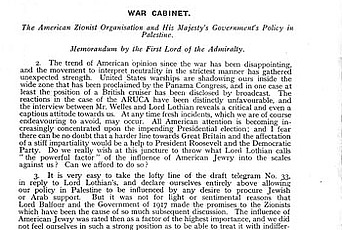Palestinian Refugees and the Humanitarian Experience

In 1948, approximately 750,000 Palestinians were displaced from their homes, going both to neighboring countries such as Jordan, Syria, and Lebanon and to the parts of Mandate Palestine that became the West Bank and the Gaza Strip. These refugees have never been allowed to return to their homes, and today there are 5 million Palestinian refugees registered with the United Nations Relief and Works Agency for Palestine Refugees (UNRWA), the body charged with providing assistance to Palestinians across the Middle East, 1.5 million of whom live in one of the 58 official UNRWA camps.
Humanitarian assistance to refugees was first provided by UN-commissioned “volunteer agencies”: the American Friends Service Committee, the International Committee of the Red Cross, and the League of Red Cross Societies. As the longevity of the crisis became apparent, the UN established UNRWA as the agency responsible for providing assistance to Palestinians in the five primary fields of displacement. This assistance has changed significantly over the years as the emergency of flight ebbed into the chronic need of long-term displacement, as new occasions of crisis erupted, as population growth strained available resources, as budgetary constraints mandated retrenchments, and as ideas about what constitutes “good” humanitarian practice have changed. Palestinians are among the world’s longest-lasting refugee populations and as such have experienced the full breadth of post–World War II humanitarianism. Their apparently exceptional experience, in fact, resonates widely.
Humanitarianism exerts a powerful claim on the global imagination. It appears to many as almost the ultimate form of doing good, a path to engagement across distance and difference that is governed by compassion and care, rather than by strategic alliances and cynical political calculations. Others are much less sanguine about the extent to which humanitarianism has so thoroughly saturated the global landscape. People express concern about what other kinds of engagements and solutions are occluded by the humanitarian frame. Among what Fiona Terry calls the “paradoxes of humanitarian action” and David Kennedy describes as the “dark sides of virtue” are the possibilities that humanitarian intervention may prolong conflicts that cause the suffering it seeks to alleviate; that principles of neutrality and confidentiality may impede calling perpetrators to account; that, in serving as gateways to assistance, procedures of refugee identification and registration may also impose restrictions on victims’ actions; and that the need to mobilize international compassion to support humanitarian endeavors may involve some degree of exploitation of people’s suffering.
Even as these constraints are real and significant, identifying them does not provide a sufficient account of humanitarian effects. There are ways in which humanitarian action, without intending to, serves as a space from which people can act politically and provides a language to press such claims. Limitation and possibility are linked in humanitarianism’s effects on those it seeks to help. We need, therefore, to understand not just the humanitarian “politics of life”—that is, calculative engagements with bodies and subjects in the management of aid delivery—but also the “politics of living”—ways that people survive, strive, and act within humanitarian spaces.
During my time as a Member in the School of Social Science at IAS, I am working on a book that explores these politics and lives across the length and much of the breadth of Palestinian exile. Displaced Palestinians live across the globe, but I focus on those who live within the jurisdiction of the humanitarian apparatus established to aid them soon after 1948. The sources for this investigation are both archival and ethnographic. The documentary record—with UNRWA’s archive at the center—includes material on the full temporal and geographic scope. My ethnographic fieldwork was conducted over a five-year period (2008–13) primarily in four refugee camps (Jerash, Wihdat, Burj al Barajneh, and Dheisheh) in three fields of operation (Jordan, Lebanon, and the West Bank). I interviewed hundreds of people in the camps, refugees from multiple generations and humanitarian workers. I also observed a number of different humanitarian projects in action.
With a more than sixty-seven-year displacement, the Palestinian refugee case is an extreme instance of a widespread phenomenon: the need for humanitarian organizations that are oriented toward emergency to respond to circumstances that are “protracted.” As Palestinian displacement has extended over many decades, and through multiple generations, the broad trajectory of the refugee experience has gone from acute crisis to chronic need. Palestinians share experiences of poverty and immobility with others around the world who are part of what is sometimes referred to as the “precariat.” Elizabeth A. Povinelli calls this sort of suffering, which often persists below the threshold of an event, “cruddy.”
Even though they are common, protracted situations strain the limits of the humanitarian imaginary, and also of humanitarian resources. Humanitarian actors cannot alleviate the causes of people’s suffering, but in crises they can effect a change in the circumstances in which they are living. In the chronic conditions usually facing Palestinians, it often seems that humanitarian actors cannot do even that. Humanitarian purpose becomes murky in circumstances where people are not in immediate risk of dying, but also where their difficult lives cannot be much improved. What can, and should, humanitarians do when nothing they do seems likely to have much effect?
Another key feature of the Palestinian experience is that the movement to the chronic is not a linear one. Palestinians have experienced long periods of persistent poverty, marginalization, and political stasis that have been repeatedly punctuated by times of acute crisis: the 1967 Israeli occupation of the West Bank and Gaza Strip, the civil war in Lebanon with its assaults on Palestinian camps (1975–90), the blockade of Gaza (2007–), and the conflict in Syria (2011–). The emergency circumstances produced by each crisis are some time thereafter transformed (again) into chronic conditions of need and restriction. One of the challenges that humanitarian actors face is being buffeted between the catastrophic and the cruddy and trying to respond alternatively to both situations.
This oscillation has consequences for both providers and recipients. For providers, these consequences include: confusion about purpose, frustration with having to cover the same ground multiple times, and anger with the apparent incapacity (or unwillingness) of political actors to resolve the underlying conditions that make emergencies repeat and chronic need persist. When the smoke clears from catastrophic violence, humanitarians make the rounds to see what remains of the lives people were living and of the projects that their agencies have supported. Humanitarian actors may be mobilized by emergency, and may understand better how to act when faced with a crisis to which they can respond directly, but they suffer the losses of these cycles of destruction. This is the humanitarian double condition produced by the returned (and ever-returning) crisis: a renewed clarity of purpose along with a growing sense of being trapped in a cycle of futility.
Palestinians live with these oscillating conditions, and the related changes in humanitarian assistance, in a variety of ways. One response, in the face of the continuing degradation of Palestinian life and the ongoing failure to reach a political resolution to the Palestine problem, is a feeling of defeat. As the generation of refugees who knew Palestine passes away—without return or resolution—many people express a sense not just of ongoing attack by Israel, but of utter abandonment by the international community, Arab states, and their own leadership. In these conditions it can be hard to imagine political alternatives. But defeat is not the only response. In the course of my research across the Middle East I have also seen people meeting these circumstances with creativity and experimentation, seeking ways around the impasses of the Palestinian present. Some work within the humanitarian apparatus that has structured so much of their lives to try to remake its impact on persons and communities. Others are engaging the camps where they live as sites of political possibility—trying out new political strategies and envisioning new sorts of futures. These are difficult times for Palestinians (and others) across the Middle East. But the experiments in “living otherwise” (as Povinelli puts it) that I encountered in my research are a reminder that these conditions are neither the whole nor the end of the story.


